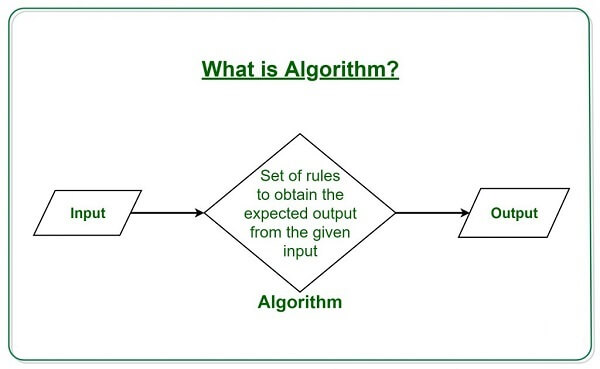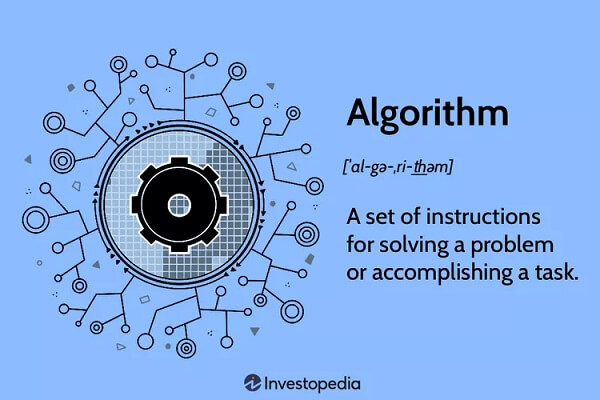Algorithm Definition:
Definition:An algorithm is a procedure that describes a set of instructions that must be carried out in a specific order to get the desired result. An algorithm may be performed in multiple computer languages since algorithms are often designed independently of the underlying languages. A few properties of an algorithm are clarity, excellence, efficacy, and language independence. An algorithm's performance and scalability are what determine how important it is. Characteristics of an Algorithm
Why is an Algorithm Needed?The following justifies your need for algorithms: 1. Scalability Your comprehension of scalability is aided by it. It must be divided into manageable parts to rapidly examine a sizeable real-world issue. 2. Performance It can be challenging to organize the actual world into manageable pieces. It is possible to complete if a work can be divided into smaller, more manageable steps. How Should an Algorithm Be Written?For writing algorithms, there are no clear guidelines. However, it is a challenge that is reliant on available resources. No particular programming language is ever considered while creating an algorithm. All programming languages have flow control structures like if-else, while, do, for, and others. These typical constructions may be used to write an algorithm. Although this is the norm, not all algorithms are constructed step-by-step. Creating algorithms takes place when the problem area has been precisely specified. The issuing domain for which you are making a solution must be understood. 
Factors Affecting the AlgorithmWhen creating an algorithm, keep the following things in mind:
If another algorithmic designer or developer wants to utilize your Algorithm, it should be expandable. Importance of AlgorithmThe Algorithm is essential because of two things:
You must divide a specific real-world challenge into more manageable pieces. It would help if you first comprehended all of the problem's theoretical components to dismantle it.
You know that theory is complete with application in the real world. As a consequence, the value of algorithms may be thought of from both a theoretical and practical standpoint. Techniques for an AlgorithmThe following methods were used after taking into account the theoretical and practical significance of constructing an algorithm: Binary Search Algorithm The generic logic framework is used in this Algorithm's creation. It is also an extensive search algorithm since it explores every avenue before delivering the needed response. These algorithms come in two varieties: When the optimal solution is identified, optimizing-finding every potential answer to a problem before choosing the greatest one-will end. When the ideal answer is identified, the act of sacrificing will end. Dividing the enemy The implementation of this Algorithm is simple. It makes it possible for you to build algorithms piecemeal. It disassembles the Algorithm to find different solutions to the issue. It enables you to break the problem into numerous approaches, producing legitimate output from legitimate input. This precise output is passed on to another process. Unfair Algorithm This algorithm paradigm aims to choose the optimal answer by making the best decision at each iteration. It takes less time to execute and is easy to set up. However, it is only the best option in a minimal number of circumstances. programmatically changing By saving interim findings, it increases the Algorithm's effectiveness. To identify the best solution to the problem to determine the ideal response to the issue, five stages are taken: Identifying the optimal solution breaks the issue down into more minor problems. It divides the issue into minor issues and then chooses the best solution from those smaller ones. Memorizing involves keeping track of the solutions to more minor problems. Reuse the outcome to avoid calculating it again for the same subproblems. It then calculates the outcome of the sophisticated program. Algorithm of Branch and Bound The branch and bound approach can only resolve integer programming issues. This technique splits all sets of viable solutions into smaller subsets. The optimal answer is then determined by further evaluating these subgroups. Using a random algorithm You have predetermined input and output, just as in a typical algorithm. Deterministic algorithms follow predefined stages and have a fixed set of inputs and outputs. Compared to non-deterministic algorithms, they are more effective. Backtracking It is an algorithmic process that iteratively discards solutions that do not adhere to the problem's restrictions. 
An Algorithm's AnalysisAll before and after it's made, the Algorithm may be studied. The analysis of the two algorithms is as follows: 1. Initial Analysis The preliminary analysis here refers to a theoretical evaluation of an algorithm before the method is implemented. Before putting the technique into practice, several variables, such as system performance, may be taken into account. 2. Reverse Analysis In this context, posterior analysis refers to a practical study of an algorithm. The Algorithm can be used to do experimental research in any programming language. The amount of space and running time necessary are determined by this analysis. The Algorithm's ComplexityThere are two methods to evaluate the effectiveness of the Algorithm: Complexity of Time Time complexity is the time needed to finish an algorithm's execution. The steps required to complete the execution are counted to determine the time complexity. The large O notation is used to indicate an algorithm's temporal complexity. In this instance, big O is the asymptotic notation used to describe temporal complexity. Let's examine a material complexity illustration. The above code's loop statement has a time complexity of at least n, and when the number of n increases, the time complexity also increases. However, since the value of the code, which returns mul, is independent of the significance of n and yields the outcome sequentially, its complexity will remain constant. Since it represents the longest computation time for any given input size, the worst complexity is often considered. Complexity of Space The amount of space required to solve a problem and produce an output is an algorithm's space complexity. The representation of space difficulty and temporal complexity is done using the Big O notation. Real-life Examples1. Putting on Shoes An algorithm is any sequential procedure finished in the same manner each time. Lacing your shoes is a fantastic illustration of this in real life. A conventional shoelace knot, sometimes called the "bunny rabbit" or "loop, swoop, and draw" knot, can only be achieved by several stages. You and your pupils probably use one of these algorithms whenever you tie your shoes. 2. Adhering to a Recipe A good illustration of an algorithm in daily life is a recipe. Similar to how an algorithm in computing science specifies ways to generate reproducible results, recipes are made to allow individuals from various backgrounds to make a specific cuisine by adhering to a set of explicit instructions. They demonstrate a repeatable series of actions to complete a particular task. Different AlgorithmsTwo categories of algorithms exist Sorting and Search Algorithm Search MethodYour search for something within your everyday life every day. Like a computer with a significant quantity of data stored in its memory, whenever a user asks for data, the computer looks for it there and gives it to them. The two main techniques for finding data in an array are: There are two categories of the search algorithm: 1. Search Linearly A simple technique called linear search starts looking for an element or value at the top of an array and keeps looking until the needed part cannot be located. The element index is given if a match is found; otherwise, -1 is returned. It analyses the object to be sought using all the entries in an array. This method can be applied to an unsorted list. 2. Binary Lookup The most fundamental Algorithm is binary, which looks for items relatively rapidly. The items must be sorted or kept sequentially to use the binary method. A sorted list is used to locate an element. Binary search cannot be used if the components are stored randomly. Sorting MethodSorting algorithms change the order of the items in an array or other data structure by placing them higher or lower. The comparison operator determines the new order of things. Different AlgorithmsThe concepts that algorithms employ to achieve a task are used to classify them. The following are the most fundamental types of algorithms, although there are many other kinds as well:
In What Areas of Computer Science Are Algorithms Used?Algorithms are used in every field of computer science. They serve as the industry's cornerstone. A computer can perform any task, whether operating a rocket or calculator, thanks to a precise set of instructions called an algorithm in computer programming. Computer programs are algorithms written in programming languages that computers can understand. Social media services, such as which postings appear, which advertisements are viewed, and so on, are greatly influenced by computer algorithms. Algorithms are used to make all of these judgments. Google's engineers use algorithms to improve search results, anticipate user input, and more. Computer programming involves learning about the creation and analysis of algorithms, which plays a significant role in problem-solving. Why is it Important to Understand Algorithms?We constantly employ algorithms and algorithmic thinking, even if we're unaware. The capacity to identify precise methods to solve a problem, or algorithmic thinking, is essential in many different domains, notably artificial intelligence and machine learning. While using algorithmic thinking, students can analyze issues and recognize solutions as separate processes. Students need to have the ability to think and reason systematically to comprehend and use an algorithm.
Next TopicAnalytical Chemistry Definition
|
 For Videos Join Our Youtube Channel: Join Now
For Videos Join Our Youtube Channel: Join Now
Feedback
- Send your Feedback to [email protected]
Help Others, Please Share










